Sensitivity of Radar Altimeter Waveform to Changes in Sea Ice Type at Resolution of Synthetic Aperture Radar
Abstract
1. Introduction
2. Data
2.1. Sentinel-1 A/B
2.2. CryoSat-2
3. Methods
3.1. SAR Image and Waveform Parameters
3.2. Freeboard
3.3. Sample Selection
4. Results
4.1. Waveform Parameter Statistics
4.2. Local Waveform Variability
5. Discussion
6. Conclusions
Author Contributions
Funding
Acknowledgments
Conflicts of Interest
References
- Dierking, W. Sea Ice Monitoring by Synthetic Aperture Radar. Oceanography 2013, 26. [Google Scholar] [CrossRef]
- Ricker, R.; Hendricks, S.; Kaleschke, L.; Tian-Kunze, X.; King, J.; Haas, C. A weekly Arctic sea-ice thickness data record from merged CryoSat-2 and SMOS satellite data. Cryosphere 2017, 11, 1607–1623. [Google Scholar] [CrossRef]
- Tilling, R.L.; Ridout, A.; Shepherd, A. Estimating Arctic sea ice thickness and volume using CryoSat-2 radar altimeter data. Adv. Space Res. 2018, 62, 1203–1225. [Google Scholar] [CrossRef]
- Alexandrov, V.; Sandven, S.; Wahlin, J.; Johannessen, O.M. The relation between sea ice thickness and freeboard in the Arctic. Cryosphere 2010, 4, 373–380. [Google Scholar] [CrossRef]
- Zygmuntowska, M.; Khvorostovsky, K.; Helm, V.; Sandven, S. Waveform classification of airborne synthetic aperture radar altimeter over Arctic sea ice. Cryosphere 2013, 7, 1315–1324. [Google Scholar] [CrossRef]
- Zygmuntowska, M. Arctic Sea Ice Altimetry—Advances and Current Uncertainties. Ph.D. Thesis, University of Bergen, Bergen, Norway, 2014. [Google Scholar]
- Rinne, E.; Similä, M. Utilisation of CryoSat-2 SAR altimeter in operational ice charting. Cryosphere 2016, 10, 121–131. [Google Scholar] [CrossRef]
- Shen, X.; Zhang, J.; Zhang, X.; Meng, J.; Ke, C. Sea Ice Classification Using Cryosat-2 Altimeter Data by Optimal Classifier–Feature Assembly. IEEE Geosci. Remote Sens. Lett. 2017, 14, 1948–1952. [Google Scholar] [CrossRef]
- Raney, R. The delay/Doppler radar altimeter. IEEE Trans. Geosci. Remote Sens. 1998, 36, 1578–1588. [Google Scholar] [CrossRef]
- Wingham, D.; Francis, C.; Baker, S.; Bouzinac, C.; Brockley, D.; Cullen, R.; de Chateau-Thierry, P.; Laxon, S.; Mallow, U.; Mavrocordatos, C.; et al. CryoSat: A mission to determine the fluctuations in Earth’s land and marine ice fields. Adv. Space Res. 2006, 37, 841–871. [Google Scholar] [CrossRef]
- Boy, F.; Desjonqueres, J.D.; Picot, N.; Moreau, T.; Raynal, M. CryoSat-2 SAR-Mode Over Oceans: Processing Methods, Global Assessment, and Benefits. IEEE Trans. Geosci. Remote Sens. 2017, 55, 148–158. [Google Scholar] [CrossRef]
- Kildegaard Rose, S. Measurements of Sea ice by Satellite and Ariborne Altimetry. Ph.D. Thesis, DTU Space—National Space Institute, Lyngby, Denmark, 2013. [Google Scholar]
- Passaro, M.; Müller, F.L.; Dettmering, D. Lead detection using Cryosat-2 delay-doppler processing and Sentinel-1 SAR images. Adv. Space Res. 2018, 62, 1610–1625. [Google Scholar] [CrossRef]
- Longepe, N.; Thibaut, P.; Vadaine, R.; Poisson, J.C.; Guillot, A.; Boy, F.; Picot, N.; Borde, F. Comparative Evaluation of Sea Ice Lead Detection Based on SAR Imagery and Altimeter Data. IEEE Trans. Geosci. Remote Sens. 2019, 57, 4050–4061. [Google Scholar] [CrossRef]
- Ulander, L.M.H. Interpretation of Seasat radar-altimeter data over sea ice using near-simultaneous SAR imagery. Int. J. Remote Sens. 1987, 8, 1679–1686. [Google Scholar] [CrossRef]
- Fetterer, F.M.; Laxon, S.; Johnson, D.R. A comparison of Geosat altimeter and synthetic aperture radar measurements over east Greenland pack ice. Int. J. Remote Sens. 1991, 12, 569–583. [Google Scholar] [CrossRef]
- Tilling, R.L.; Ridout, A.; Shepherd, A. Near-real-time Arctic sea ice thickness and volume from CryoSat-2. Cryosphere 2016, 10, 2003–2012. [Google Scholar] [CrossRef]
- Karvonen, J.; Cheng, B.; Vihma, T.; Arkett, M.; Carrieres, T. A method for sea ice thickness and concentration analysis based on SAR data and a thermodynamic model. Cryosphere 2012, 6, 1507–1526. [Google Scholar] [CrossRef]
- Laxon, S.W.; Giles, K.A.; Ridout, A.L.; Wingham, D.J.; Willatt, R.; Cullen, R.; Kwok, R.; Schweiger, A.; Zhang, J.; Haas, C.; et al. CryoSat-2 estimates of Arctic sea ice thickness and volume. Geophys. Res. Lett. 2013, 40, 732–737. [Google Scholar] [CrossRef]
- Komarov, A.S.; Buehner, M. Detection of First-Year and Multi-Year Sea Ice from Dual-Polarization SAR Images Under Cold Conditions. IEEE Trans. Geosci. Remote Sens. 2019, 1–15. [Google Scholar] [CrossRef]
- Kaur, S.; Ehn, J.K.; Barber, D.G. Pan-arctic winter drift speeds and changing patterns of sea ice motion: 1979–2015. Polar Rec. 2018, 54, 303–311. [Google Scholar] [CrossRef]
- Scagliola, M. CryoSAT Footprints; Technical Report, Aresys Technical Note. 2013. Available online: https://earth.esa.int/documents/10174/125271/CryoSat_Footprints_TN_v1.1.pdf/2a5d996b-8b77-4d1c-ae7b-fbf93848c35d;jsessionid=B1FF8C50A1B0F2A0879F6FA028844644.eodisp-prod4040?version=1.0 (accessed on 29 September 2019).
- European Space Agenncy. CryoSAT-2 Product Handbook; C2-LI-ACS-ESL-5319; European Space Agenncy: Paris, France, 2018. [Google Scholar]
- Onstott, R.G. SAR and Scatterometer Signatures of Sea Ice. In Microwave Remote Sensing of Sea Ice; Carsey, F.D., Ed.; American Geophysical Union: Washington, DC, USA, 1992; Chapter 5; pp. 73–102. [Google Scholar]
- Fetterer, F.M.; Drinkwater, M.R.; Jezek, K.J.; Laxon, S.W.C.; Onstott, R.G.; Ulander, L.M.H. Sea Ice Altimetry. In Microwave Remote Sensing of Sea Ice; Carsey, F.D., Ed.; American Geophysical Union: Washington, DC, USA, 1992; Chapter 7; pp. 111–135. [Google Scholar]
- Ricker, R.; Hendricks, S.; Helm, V.; Skourup, H.; Davidson, M. Sensitivity of CryoSat-2 Arctic sea-ice freeboard and thickness on radar-waveform interpretation. Cryosphere 2014, 8, 1607–1622. [Google Scholar] [CrossRef]
- Quartly, G.D.; Rinne, E.; Passaro, M.; Andersen, O.B.; Dinardo, S.; Fleury, S.; Guillot, A.; Hendricks, S.; Kurekin, A.A.; Müller, F.L.; et al. Retrieving Sea Level and Freeboard in the Arctic: A Review of Current Radar Altimetry Methodologies and Future Perspectives. Remote Sens. 2019, 11, 881. [Google Scholar] [CrossRef]
- Brockley, D.J. CryoSat2: L2 Design Summary Document; CS-DD-MSL-GS-2002; 2019. Available online: https://earth.esa.int/documents/10174/125272/CryoSat-L2-Design-Summary-Document (accessed on 29 September 2019).
- Landy, J.C.; Tsamados, M.; Scharien, R.K. A Facet-Based Numerical Model for Simulating SAR Altimeter Echoes From Heterogeneous Sea Ice Surfaces. IEEE Trans. Geosci. Remote Sens. 2019, 57, 4164–4180. [Google Scholar] [CrossRef]
- Ricker, R.; Hendricks, S.; Perovich, D.K.; Helm, V.; Gerdes, R. Impact of snow accumulation on CryoSat-2 range retrievals over Arctic sea ice: An observational approach with buoy data. Geophys. Res. Lett. 2015, 42, 4447–4455. [Google Scholar] [CrossRef]
- Fons, S.W.; Kurtz, N.T. Retrieval of snow freeboard of Antarctic sea ice using waveform fitting of CryoSat-2 returns. Cryosphere 2019, 13, 861–878. [Google Scholar] [CrossRef]
- Nilsson, J.; Vallelonga, P.; Simonsen, S.B.; Sørensen, L.S.; Forsberg, R.; Dahl-Jensen, D.; Hirabayashi, M.; Goto-Azuma, K.; Hvidberg, C.S.; Kjær, H.A.; et al. Greenland 2012 melt event effects on CryoSat-2 radar altimetry. Geophys. Res. Lett. 2015, 42, 3919–3926. [Google Scholar] [CrossRef]
- Drinkwater, M.R. Ku-band airborne radar altimeter observations of marginal sea ice during the 1984 Marginal Ice Zone Experiment. J. Geophys. Res. 1991, 96, 4555. [Google Scholar] [CrossRef]
- Ulander, L. Observations Of Ice Types In Satellite Altimeter Data. In Proceedings of the International Geoscience and Remote Sensing Symposium, Remote Sensing: Moving Toward the 21st Century, Edinburgh, UK, 12–16 September 1988. [Google Scholar] [CrossRef]
- Armitage, T.W.K.; Davidson, M.W.J. Using the Interferometric Capabilities of the ESA CryoSat-2 Mission to Improve the Accuracy of Sea Ice Freeboard Retrievals. IEEE Trans. Geosci. Remote Sens. 2014, 52, 529–536. [Google Scholar] [CrossRef]
- Tonboe, R.T.; Pedersen, L.T.; Haas, C. Simulation of the CryoSat-2 satellite radar altimeter sea ice thickness retrieval uncertainty. Can. J. Remote Sens. 2010, 36, 55–67. [Google Scholar] [CrossRef]
- Ricker, R.; Hendricks, S.; Helm, V.; Gerdes, R. Classification of CryoSat-2 Radar Echoes. In Towards an Interdisciplinary Approach in Earth System Science: Advances of a Helmholtz Graduate Research School; Lohmann, G., Meggers, H., Unnithan, V., Wolf-Gladrow, D., Notholt, J., Bracher, A., Eds.; Springer International Publishing: Cham, Switzerland, 2015; pp. 149–158. [Google Scholar] [CrossRef]
- Wernecke, A.; Kaleschke, L. Lead detection in Arctic sea ice from CryoSat-2: Quality assessment, lead area fraction and width distribution. Cryosphere 2015, 9, 1955–1968. [Google Scholar] [CrossRef]
- Kwok, R.; Cunningham, G.F. Variability of Arctic sea ice thickness and volume from CryoSat-2. Philos. Trans. R. Soc. A Math. Phys. Eng. Sci. 2015, 373, 20140157. [Google Scholar] [CrossRef]
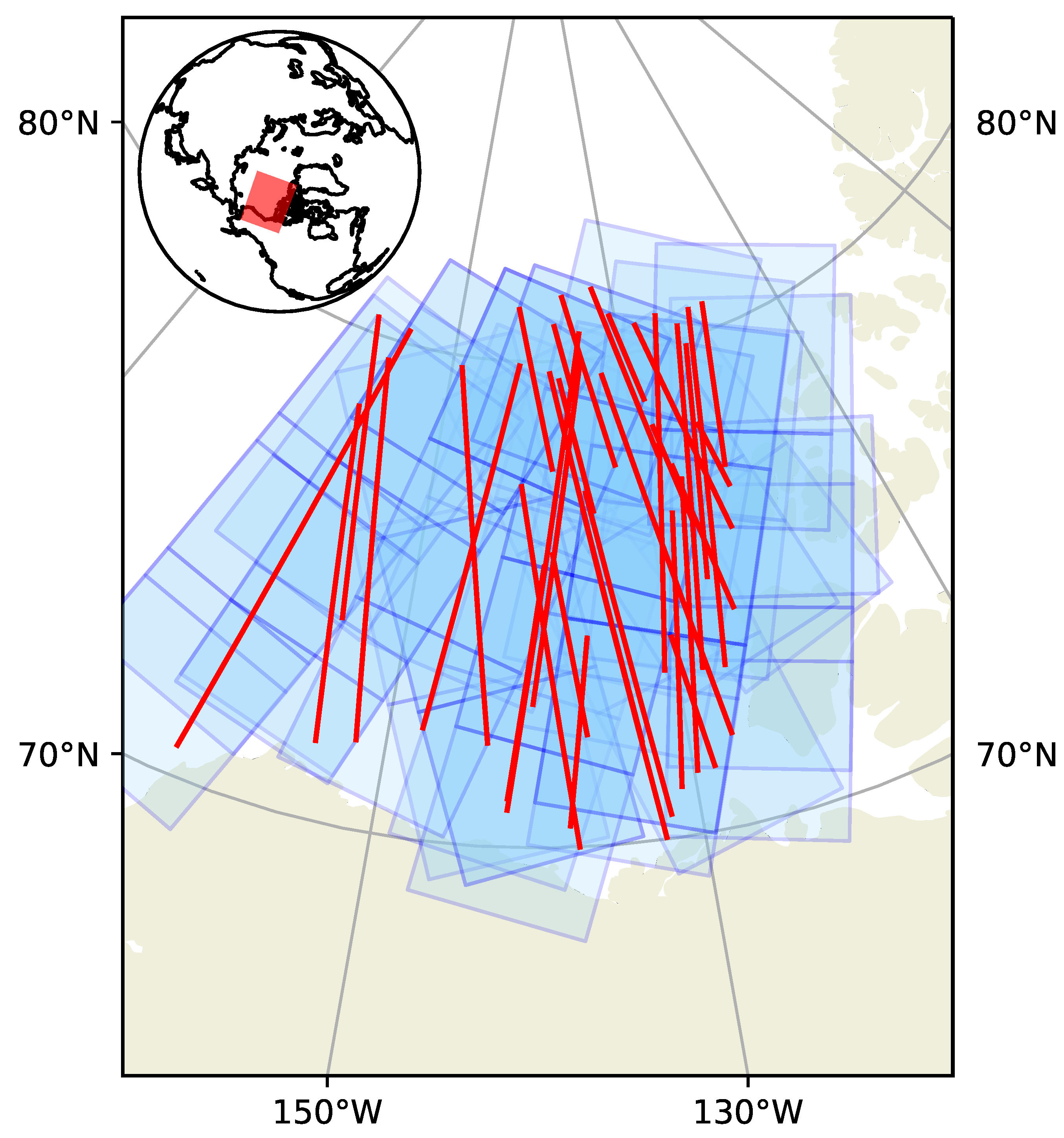

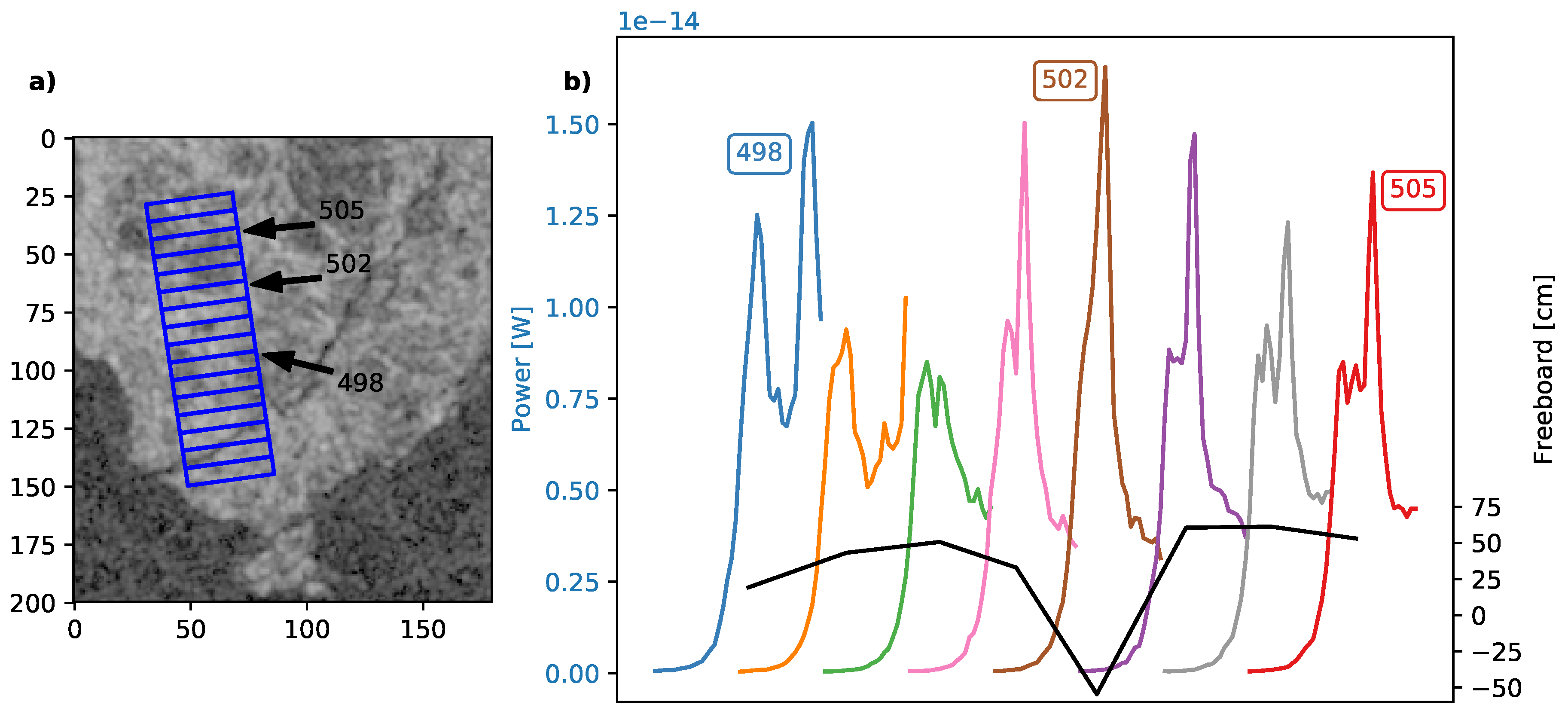




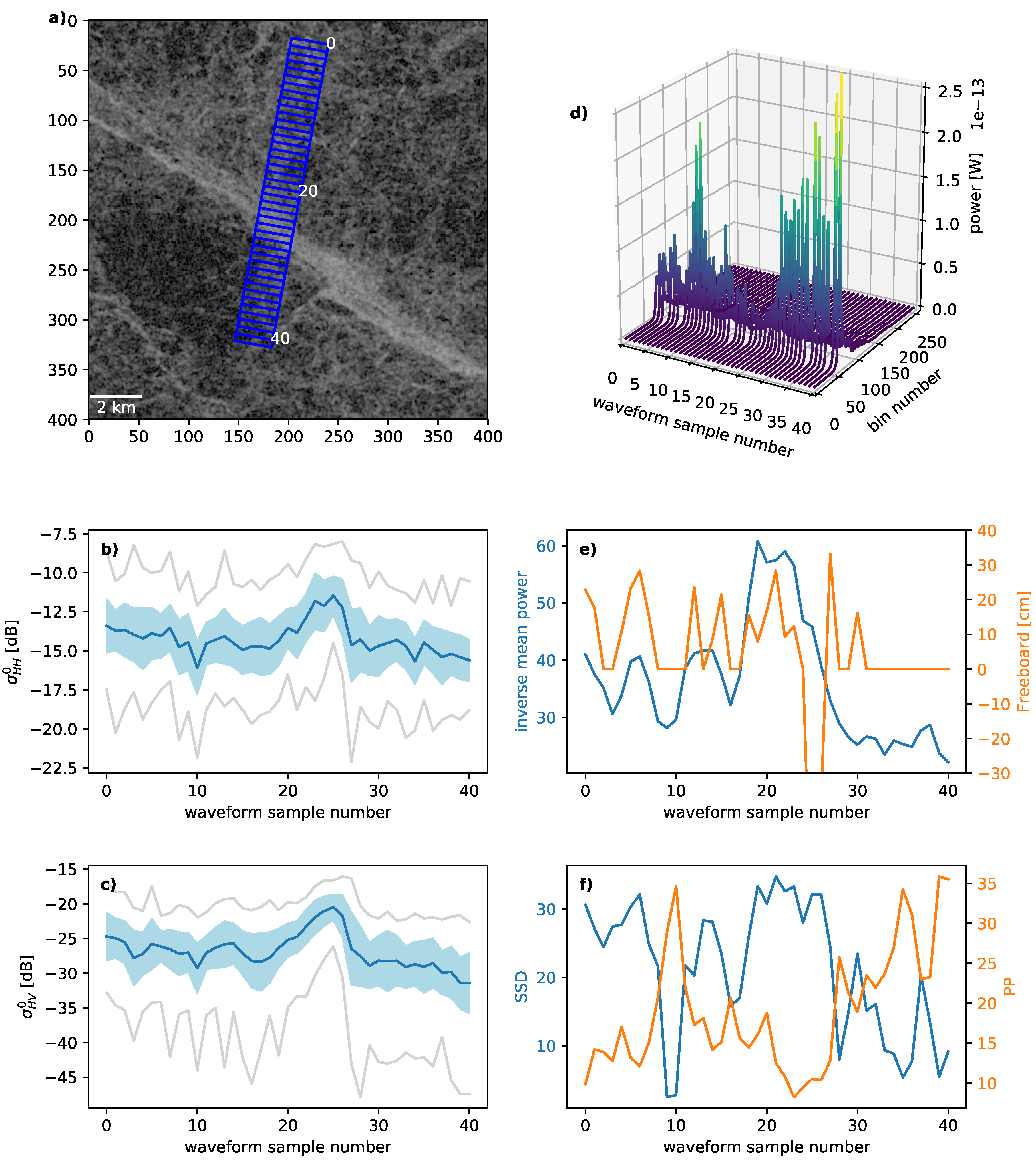
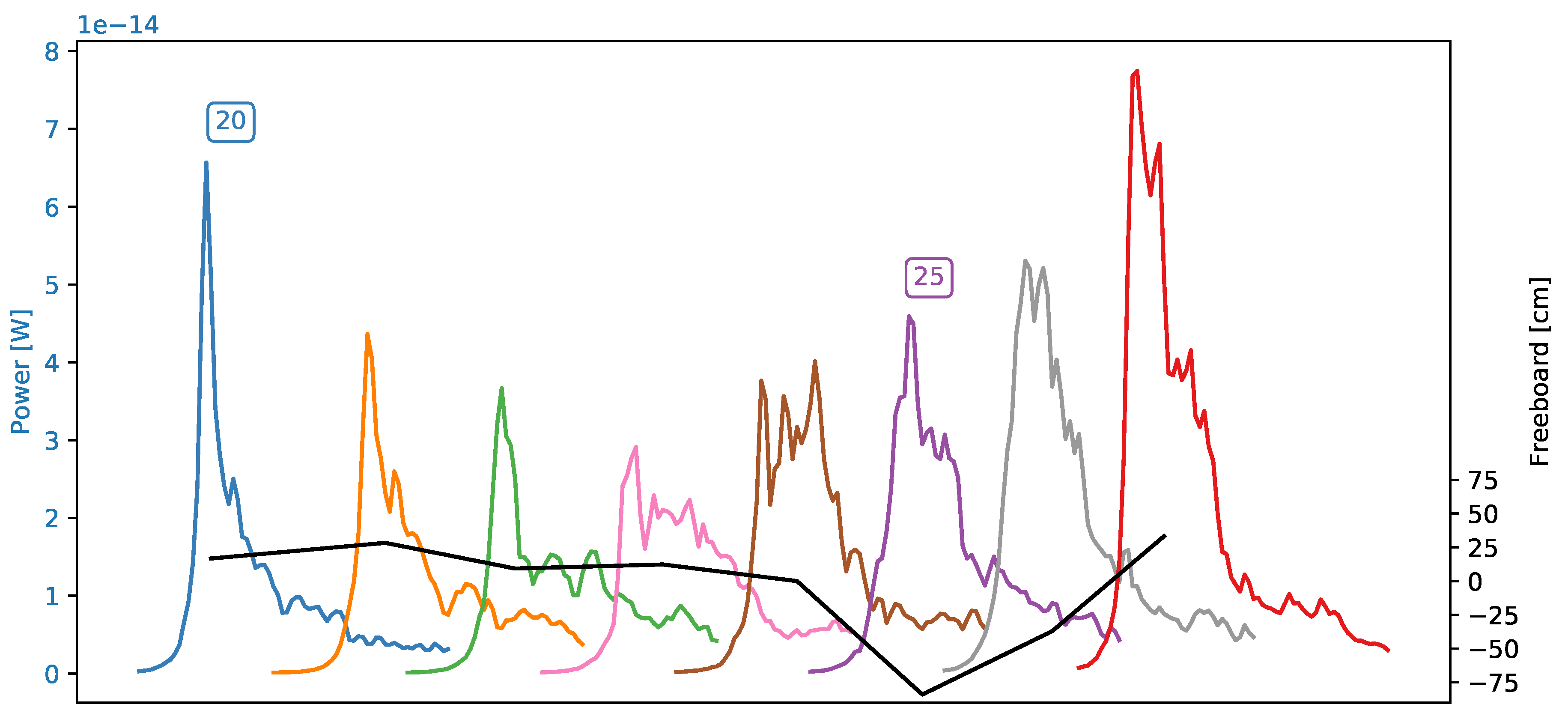
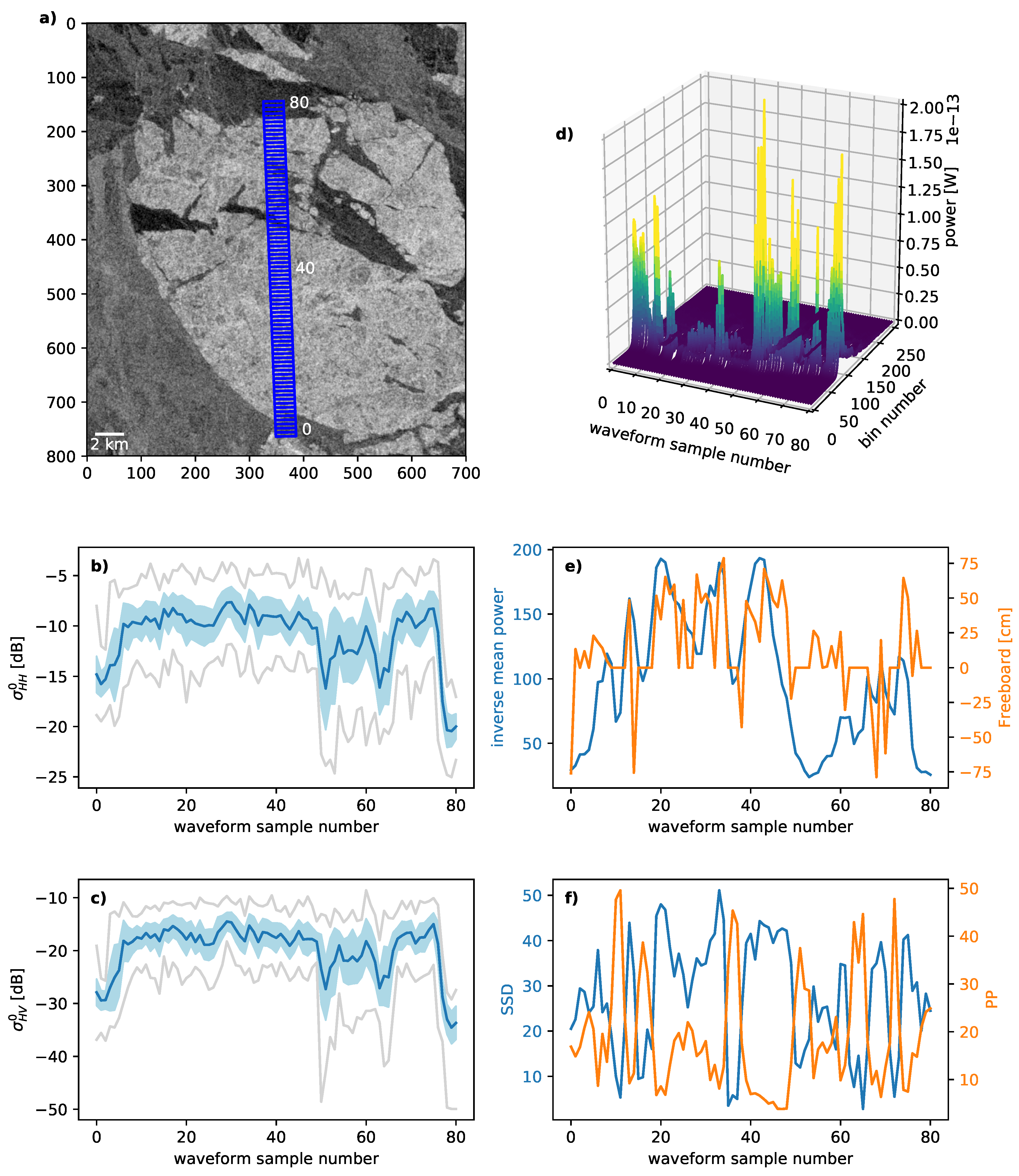
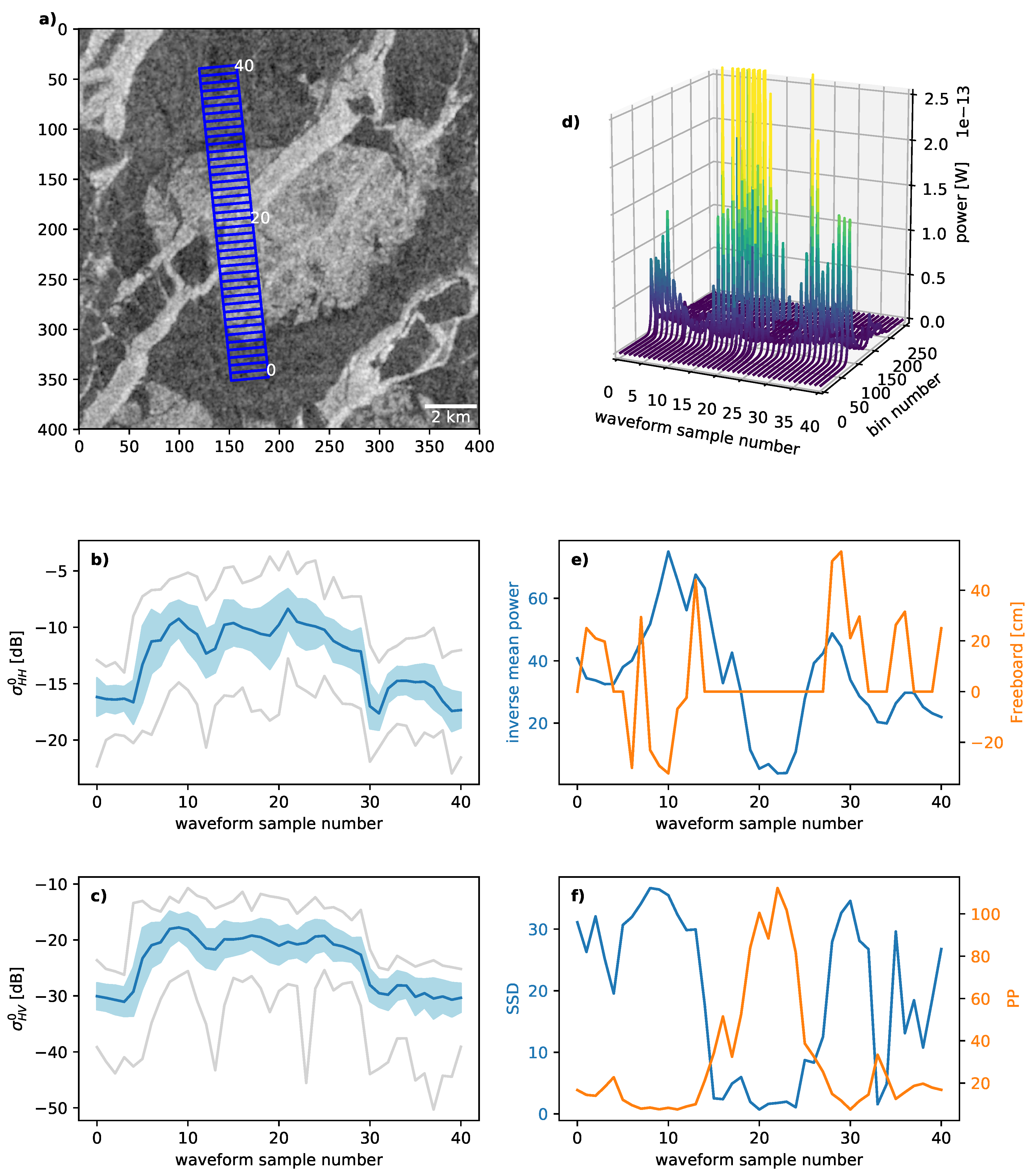
| Date | Number of Images | Number of Sequences | Mean Time Lag [min] | Min/Max Time Lag [min] |
|---|---|---|---|---|
| Feb 2016 | 3 | 1 | 61 | - |
| Mar 2016 | 12 | 6 | 27 | 3/54 |
| Nov 2016 | 6 | 3 | 46 | 28/69 |
| Dec 2016 | 9 | 4 | 27 | 2/40 |
| Jan 2017 | 5 | 2 | 44 | 27/61 |
| Jan 2018 | 4 | 2 | 55 | 53/56 |
| Feb 2018 | 28 | 14 | 33 | 4/74 |
| Mar 2018 | 6 | 4 | 44 | 26/75 |
| Total | 73 | 36 |
| Season | Number of FYI Samples | Number of MYI Samples | Number of Large Leads Samples |
|---|---|---|---|
| 2015/2016 | 789 | 4048 | 837 |
| 2016/2017 | 4217 | 1782 | 10 |
| 2017/2018 | 2582 | 5033 | 86 |
| Total | 7588 | 10862 | 933 |
© 2019 by the authors. Licensee MDPI, Basel, Switzerland. This article is an open access article distributed under the terms and conditions of the Creative Commons Attribution (CC BY) license (http://creativecommons.org/licenses/by/4.0/).
Share and Cite
Aldenhoff, W.; Heuzé, C.; Eriksson, L.E.B. Sensitivity of Radar Altimeter Waveform to Changes in Sea Ice Type at Resolution of Synthetic Aperture Radar. Remote Sens. 2019, 11, 2602. https://doi.org/10.3390/rs11222602
Aldenhoff W, Heuzé C, Eriksson LEB. Sensitivity of Radar Altimeter Waveform to Changes in Sea Ice Type at Resolution of Synthetic Aperture Radar. Remote Sensing. 2019; 11(22):2602. https://doi.org/10.3390/rs11222602
Chicago/Turabian StyleAldenhoff, Wiebke, Céline Heuzé, and Leif E. B. Eriksson. 2019. "Sensitivity of Radar Altimeter Waveform to Changes in Sea Ice Type at Resolution of Synthetic Aperture Radar" Remote Sensing 11, no. 22: 2602. https://doi.org/10.3390/rs11222602
APA StyleAldenhoff, W., Heuzé, C., & Eriksson, L. E. B. (2019). Sensitivity of Radar Altimeter Waveform to Changes in Sea Ice Type at Resolution of Synthetic Aperture Radar. Remote Sensing, 11(22), 2602. https://doi.org/10.3390/rs11222602






